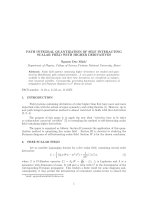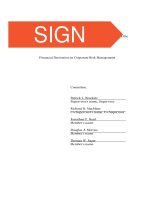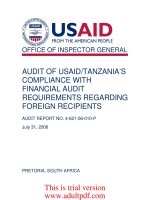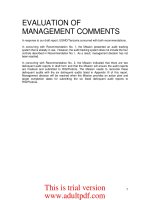hedging with financial derivatives
Bạn đang xem bản rút gọn của tài liệu. Xem và tải ngay bản đầy đủ của tài liệu tại đây (478.44 KB, 37 trang )
Copyright 2011
Pearson Canada Inc.
14 -
1
Chapter 14
Hedging with Financial Derivatives
Copyright 2011
Pearson Canada Inc.
14 -
2
Hedging I
Hedge - engage in a financial transaction that
reduces or eliminates risk
Long position - taking a position associated with
the purchase of an asset
Short position – taking a position associated with
the sale of an asset
Copyright 2011
Pearson Canada Inc.
14 -
3
Hedging II
Basic hedging principle:
Hedging risk involves engaging in a financial
transaction that offsets a long position by taking a
additional short position, or offsets a short
position by taking a additional long position
Copyright 2011
Pearson Canada Inc.
14 -
4
Forward Contracts and Markets
•
A forward contract is an agreement between a buyer
and a seller that an asset will be exchanged for cash
at some later date at a price agreed upon now.
•
Forward contracts are traded over-the-counter (OTC)
•
Two types discussed:
–
Interest-rate forward contracts
–
Forward contracts for foreign currencies
Copyright 2011
Pearson Canada Inc.
14 -
5
Interest Rate Forward Contracts
•
An interest rate forward contract involves the
future sale (purchase) of a debt instrument
•
Contract specifies
-Specification of the debt instrument
- Amount of the instrument to be delivered
- The price (interest rate) on the instrument
when it is delivered
- The date when delivery takes place
Copyright 2011
Pearson Canada Inc.
14 -
6
Interest-Rate Forward Markets I
•
Long position = agree to buy securities at future
date
•
Hedges by locking in future interest rate if funds
coming in future
•
Short position = agree to sell securities at future
date
•
Hedges by reducing price risk from change in
interest rates if holding bonds
Copyright 2011
Pearson Canada Inc.
14 -
7
Interest-Rate Forward Markets II
Pros
1. Flexible (can be used to hedge completely the interest
rate risk)
Cons
1. Lack of liquidity: hard to find a counterparty to make a
contract with
2. Subject to default risk: requires information to screen
good from bad risk
Copyright 2011
Pearson Canada Inc.
14 -
8
Financial Futures Markets
Financial futures are classified as
•
Interest-rate futures
•
Stock index futures, and
•
Currency futures
Copyright 2011
Pearson Canada Inc.
14 -
9
Interest Rate Features
Copyright 2011
Pearson Canada Inc.
14 -
10
Interest Rate Futures Markets I
Interest Rate Futures Contract
1. Specifies delivery of type of security at future date
2. Arbitrage ⇒ at expiration date, price of contract =
price of the underlying asset delivered
3. i ↑, long contract has loss, short contract has profit
4. Hedging similar to forwards
Copyright 2011
Pearson Canada Inc.
14 -
11
Interest Rate Futures Markets II
•
At the expiration date of a futures contract, the
price of the contract is the same as the price of
the underlying asset to be delivered
•
The elimination of riskless profit opportunities in
the futures market is referred to as arbitrage
•
A micro hedge occurs when the institution is
hedging the interest rate for a specific asset it is
holding
•
A macro hedge is when the hedge is for the
entire portfolio
Copyright 2011
Pearson Canada Inc.
14 -
12
Financial Futures Markets
•
Organization and Trading
–
CBOT, Chicago Mercantile Exchange, Montreal
Exchange, London International Financial futures
Exchange, Marché à Terme International de
France
–
Open interest – number of contracts outstanding
•
Globalization
Copyright 2011
Pearson Canada Inc.
14 -
13
Interest Rate Futures Markets III
Explaining the Success of Future Markets:
•
Futures more liquid: standardized, can be traded
again, delivery of range of securities
•
Delivery of range of securities prevents corner
•
ark to market: avoids default risk
•
Don’t have to deliver: netting
Copyright 2011
Pearson Canada Inc.
14 -
14
Financial Futures Contracts in the U.S.
Copyright 2011
Pearson Canada Inc.
14 -
15
Stock Index Futures Contracts I
•
Stock index futures were designed to manage
stock market risk and are now among the most
widely traded of all futures contracts
•
The S&P Index measures the value of 500 of the
most widely traded stocks in the United States
•
Price quotes for this contract are also quoted in
terms of index points
–
Change of 1 point represents a change of $250 in the
contract’s value.
Copyright 2011
Pearson Canada Inc.
14 -
16
Stock Index Futures Contracts II
•
Stock index future contracts differ form most
other types of financial futures contracts in that
they are settled in cash delivery rather than
delivery of a security
•
Cash settlement gives a high degree of liquidity
•
For a S&P 500 Index, contract, at the final
settlement date, the cash delivery due is $250
times the Index
•
If the Index is 1000 on the settlement date, $250
000 is the amount due
Copyright 2011
Pearson Canada Inc.
14 -
17
Stock Index Futures Contracts III
•
Suppose on February 1 you sell one June
contract at a price of 1000 ($250 000)
•
If the S&P falls to 900 on the expiration date, the
buyer of the contract will have lost $25 000 (loss
of 100 points @ $250 a point)
•
Buyer agreed to pay $250 000 (1000 x $250) for
something currently valued at $225 000 (900 x
$250)
Copyright 2011
Pearson Canada Inc.
14 -
18
Stock Index Futures Contracts IV
•
The seller of the contract will profit $25 000 (100 x
$250) as you agreed to receive $250 000 as the
purchase price for the contract which is now valued at
$225 000
•
Because the amounts are payable/due are netted out,
only $25 000 changes hands as you the seller receive
this amount from the buyer
Copyright 2011
Pearson Canada Inc.
14 -
19
Options I
•
A call option is an option that gives the owner
the right (but not the obligation) to buy an asset
at a pre specified exercise (or strike) price within
a specified period of time.
•
Since a call represents an option to buy, the
purchase of a call is undertaken if the price of the
underlying asset is expected to go up.
Copyright 2011
Pearson Canada Inc.
14 -
20
Options II
•
The buyer of a call is said to be long in a call
and the writer is said to be short in a call.
•
The buyer of a call will have to pay a premium
in order to get the writer to sign the contract
and assume the risk.
Copyright 2011
Pearson Canada Inc.
14 -
21
Options III
•
There are two types of option contracts:
1. American options that can be exercised any
time up to the expiration date
2. European options that can be exercised only on
the expiration date
•
Stock options
•
Financial futures options (futures options)
Copyright 2011
Pearson Canada Inc.
14 -
22
The Payoff from Buying a Call
To understand calls, let's assume that you hold a European call on
an asset with an exercise price of X and a call premium of α.
•
If at the expiration date, the price of the underlying asset, S, is less
than X, the call will not be exercised, resulting in a loss of the
premium.
•
At a price above X, the call will be exercised. In particular, at a
price between X and X + α, the gain would be insufficient to cover
the cost of the premium, while at a price above X + α the call will
yield a net profit.
•
In fact, at a price above X + α, each $1 rise in the price of the asset
will cause the profit of the call option to increase by $1.
Copyright 2011
Pearson Canada Inc.
14 -
23
The Payoff from Writing a Call
The payoff function from writing the call option is the
mirror image of the payoff function from buying the call.
Note that the writer of the call receives the call
premium, α, up front and must stand ready to sell the
underlying asset to the buyer of the call at the exercise
price, X, if the buyer exercises the option to buy.
Copyright 2011
Pearson Canada Inc.
14 -
24
Profits from Buying and Writing a Call Option
Copyright 2011
Pearson Canada Inc.
14 -
25
Summary
In general, the value of a call option, C, at expiration with asset
price S (at that time) and exercise price X is
C = max (0, S - X)
In other words, the value of a call option (intrinsic value) at
maturity is S - X, or zero, whichever is greater.
•
If S > X, the call is said to be in the money, and the owner will
exercise it for a net profit of C - α.
•
If S < X, the call is said to be out of the money and will expire
worthless.
•
A call with S = X is said to be at the money (or trading at par).









